
September 18, 2012 at 10:30 am
Published by Stanford Blood Center
I woke up one Tuesday and knew it was going to be a crappy day. I asked my daughter to get herself ready for school and wake me when it was time for me to drive her there. I e-mailed my personal trainer and cancelled my first appointment to launch a workout routine. Even showering felt like too much effort.
September 14, 2012 at 2:09 pm
Published by Stanford Blood Center
By Billie Rubin, Hemoglobin's Catabolic Cousin, reporting from the labs of Stanford Blood Center
Cytomegalovirus (CMV) is a virus that 50 - 85% of adults have been exposed to at some point in their lives. It is passed by person-to-person contact with body fluids, and it is in the same family of viruses that cause chicken pox and mononucleosis. In healthy people, it rarely results in serious illness and can remain dormant in their bodies for the rest of their lives.
September 10, 2012 at 1:55 pm
Published by Stanford Blood Center
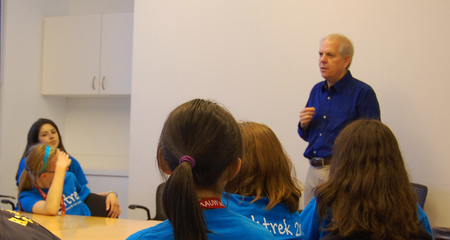
By Dayna Myers, Marketing Communications Manager, Stanford Blood Center
Stanford Blood Center founder and Medical Director Ed Engleman, MD, took a break from the lab to share his inspiring story with a group of students from the Tech Trek science and math camp on July 16.
September 5, 2012 at 4:19 pm
Published by Stanford Blood Center

A message from Dr. Susan Galel, Director of Clinical Operations, Stanford Blood Center
If you are one of our dedicated platelet pheresis donors, you know that we keep careful records of how much you donate and how oftenin the familiar Annual Donor Records tucked in your chart. It is our responsibility to ensure that your donation frequency is safe for you. Before each of your donations, we tally all of your visits, red blood cell losses and plasma losses for the 12 months prior to that donation, to be sure that you will not exceed any of the safety limits.
August 31, 2012 at 8:44 am
Published by Stanford Blood Center
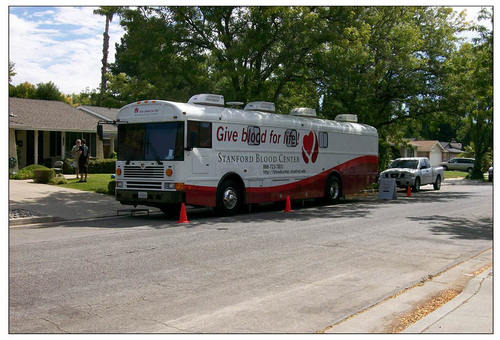
By Deanna Bolio, Public Relations Associate, Stanford Blood Center
Stanford Blood Center Bloodmobiles travel thousands of miles each year to collect donations at mobile blood drives. They stop at businesses and schools, churches and hospitals. But you might be surprised to know that on rare occasions you can even catch these buses on quiet residential streets, parked next to yard sale signs and driveway basketball hoops. These community blood drives, often associated with a particular patient or blood recipient, offer a unique opportunity for a community to come together for a good cause.
August 28, 2012 at 3:31 pm
Published by Stanford Blood Center
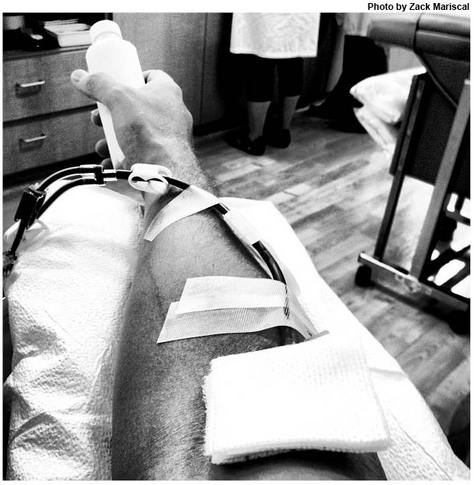
By Julie Ruel, Social Media Manager, Stanford Blood Center
At Stanford Blood Center, we collect a combination of blood products (red blood cells, platelets, plasma) using different procedures and equipment. For the scope of this article, we'll focus on two types of red blood cell donations: single unit and double unit.
August 23, 2012 at 8:49 am
Published by Stanford Blood Center
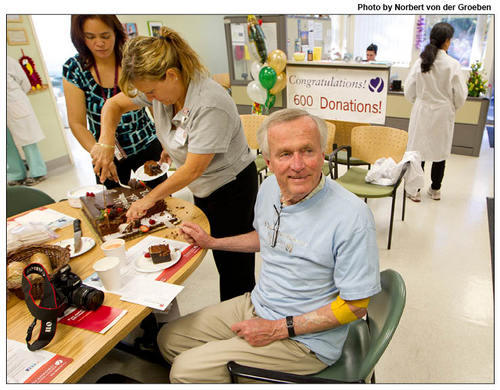
By Dayna Myers, Marketing Communications Manager, Stanford Blood Center
After more than two decades' worth of visits, blood donor David "Mitch" Mitchell hit a unique milestone on August 20 when he became the first person to make 600 donations at Stanford Blood Center.

August 15, 2012 at 12:39 pm
Published by Stanford Blood Center
When Randy Helmonds, wife Lisa, and their two teenage boys donate blood, they take an unconventional approach. Why sit quietly in the donor chair when it can be so much more exciting? "Creating a friendly, competitive environment is a fun direction to go," shares Randy who wants blood donation to be something his family looks forward to.
August 13, 2012 at 11:46 am
Published by Stanford Blood Center
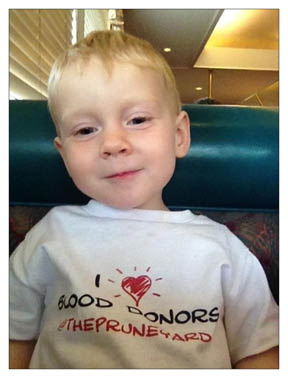
By Sinead Borgersen, Coordinator for Nimsoft Blood Drives
My two-year-old son Faelan has a hereditary red blood cell fragility disorder called hereditary spherocytosis. He inherited it from me and I inherited from my mother with another of my siblings. His red blood cells are fragile and spherical in shape instead of the normal donut shape due to a defective gene that causes the shell to be misshapen, like a pole missing in a tent. His red blood cells live a shorter life and the spleen becomes enlarged as it attacks the red blood cells, causing them to live a very shortened lifespan of 3-10 days. So he is anemic and fatigues easily.
August 2, 2012 at 4:49 pm
Published by Stanford Blood Center

By Julie Ruel, Social Media Manager, Stanford Blood Center
Voluntary blood donors are needed in countries throughout the world to help maintain a safe and sufficient blood supply. Finding these donors is often a challenge for blood centers. So, many advocates have created unusual awareness campaigns to promote the need. Here are some of the most inventive efforts we've seen.








